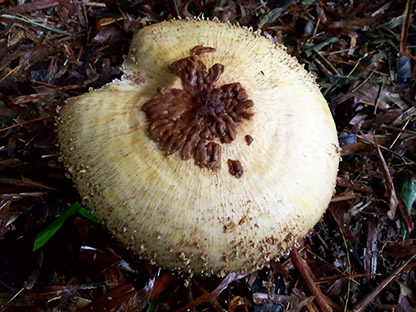RECENT COLLECTION OF THE POISONOUS MUSHROOM, Clarkeinda trachodes (Berk.) FOR INDONESIA

Downloads
Clarkeinda trachodes is an interesting agaric and has been acknowledged as one of the poisonous mushrooms worldwide. This species has mentioned to be found in tropical regions of Asia, including Indonesia. However, no clear record has been found regarding the primary information and herbarium collection of this species in Indonesia. During our regular mushroom foraging at IPB University campus forest Indonesia, the basidiomata of Clarkeinda was encountered. The current study aimed to confirm the taxonomical position of our specimens based on morphological and molecular evidence. Fresh basidomata was observed on the macro- and micromorphological features. The molecular analysis and phylogenetic tree construction were done based on ITS 1/2 sequence. The combination of morphological and molecular evidence confirmed our specimen as C. trachodes. Morphologically, Clarkeinda trachodes BO24637 can be determined by a large basidiocarp of Agaricales, prominent pellicle on disc pileus, notable ring, reddish brown context and stipe when injured, and truncate apex of basidiospores. The BLAST result showed that our specimen has a high similarity to C. trachodes as the top hits. In addition, the phylogenetic tree constructed by ITS sequence committed specimen BO24637 as C. trachodes with 100% BS value. The current study resolves a clear and accessible document of C. trachodes in Indonesia. In addition, we provided the morphological and molecular information as well as herbarium collection of C. trachodes in Indonesia, which can be used for future study of this species.
Downloads
Berkeley MJ. 1847. Decades of fungi XV−XIX. Ceylon fungi. London J Bot 6: 479-514.
Boedijn KB. 1934. The genus Chiloniella with remarks on the Chlorosporae. Bull jard bot Buitenzorg 13:
-280.
Goldstein JI, Newbury DE, Echlin P, Joy DC, Romig Jr AD, Lyman CE, Fiori 10C, Lifshin E. 1992. Scanning electron microscopy and X-ray microanalysis 2nd 11 edn. New York: Plenum Press. DOI: https://doi.org/10.1007/978-1-4613-0491-3
Hosen I, Ge ZW. 2012. Clarkeinda trachodes (Agaricales, Basidiomycetes), first record from Bangladesh. Mycotaxon 118: 331-336. DOI: https://doi.org/10.5248/118.331
Index Fungorum [Internet]. 2023. Clarkeinda trachodes. [Accessed on 18 January 2024]. Available from: https://www.indexfungorum.org/Names/NamesRecord.asp?RecordID=294937
Kumar M, Kaviyarasan V. 2011. A rare agaric (Agaricomycetes: Agaricaceae) from a sacred grove of Eastern Ghats, India. JOTT 3: 1778-1781. DOI: https://doi.org/10.11609/JoTT.o2626.1778-81
Kumar S, Stecher G, Li M, Knyaz C, Tamura K. 2018. MEGA X: Molecular Evolutionary Genetics Analysis across Computing Platforms. Mol Biol Evol 35: 1547-1549. DOI: https://doi.org/10.1093/molbev/msy096
Kuntze O. 1891. RcUiSio Gcncrurn Planfarum. 2: 377-1011. Leipzig: Arthur Felix.
Læssøe T, Pedersen OS, Sysouphanthong P. 2019. An introduction to the edible, poisonous and medicinal fungi of northern Laos. Laos: FAO.
Leelavathy KM, Zachariah S, Sankaran KV. 1981. Clarkeinda trachodes—An agaric new to India. Mycologia 73: 204-207. DOI: https://doi.org/10.1080/00275514.1981.12021334
Lavorato C, Contu M. 2002. Clarkeinda trachodes, una specie nuova per la micoflora italiana rinvenuta in Calabria. [ Clarkeinda trachodes, a new species for the Italian mycoflora found in Calabria] Boll Gruppo Micol G Bresadola 45: 33-39.
Pegler DN. 1985. The genus Clarkeinda (Basidiomycotina: Agaricaceae). Bot J Linn Soc 91: 245-252. DOI: https://doi.org/10.1111/j.1095-8339.1985.tb01148.x
Petch T. 1908. The genus Chifoniclla. Ann Roy Bot Gard 4: 113-122.
Sysouphanthong P, Thongklang N, Liu J-K, Vellinga EC. 2021. Description of Lepiotaceous Fungal Species of the Genera Chlorophyllum, Clarkeinda, Macrolepiota, Pseudolepiota, and Xanthagaricus, from Laos and Thailand. Diversity 13: 666. DOI: https://doi.org/10.3390/d13120666
Verma RK, Tiwari C, Parihar J, Kumar S. 2016. Diversity of macro-fungi in central India-II: Clarkeinda trachodes. Van Sangyan 3: 17-20.
White TJ, Bruns T, Lee SJ, Taylor JW. 1990. Amplification and directsequencing of fungal ribosomal RNA genes for phylogenetics. In: Innis M, Gelfand D, Sninsky J, White T (Eds.), PCR Protocols. New York: Academic Press, pp. 315-322. DOI: https://doi.org/10.1016/B978-0-12-372180-8.50042-1
Yang ZL.1991. Clarkeinda trachodes, an agaric new to China. Plant Divers 13: 279-282.
Copyright (c) 2024 Ivan Permana Putra, Oktan Dwi Nurhayat, Wahyu AJi Mahardika, Okta Yulia Sari

This work is licensed under a Creative Commons Attribution-NonCommercial-NoDerivatives 4.0 International License.
Authors who publish with this journal agree with the following terms:
- Authors retain copyright and grant the journal right of first publication, with the work 1 year after publication simultaneously licensed under a Creative Commons attribution-noncommerical-noderivates 4.0 International License that allows others to share, copy and redistribute the work in any medium or format, but only where the use is for non-commercial purposes and an acknowledgement of the work's authorship and initial publication in this journal is mentioned.
- Authors are able to enter into separate, additional contractual arrangements for the non-exclusive distribution of the journal's published version of the work (e.g., post it to an institutional repository or publish it in a book), with an acknowledgement of its initial publication in this journal.
- Authors are permitted and encouraged to post their work online (e.g., in institutional repositories or on their website) prior to and during the submission process, as it can lead to productive exchanges, as well as earlier and greater citation of published work (See The Effect of Open Access).



























